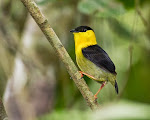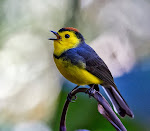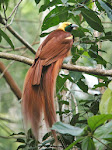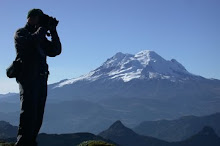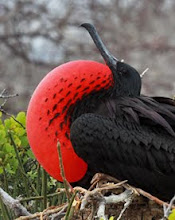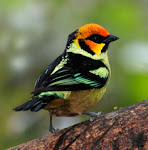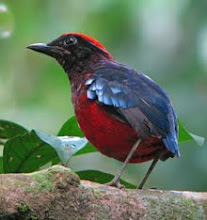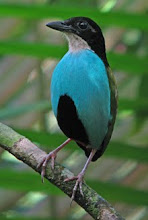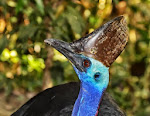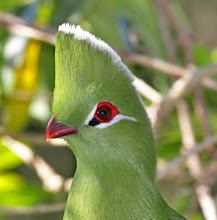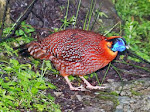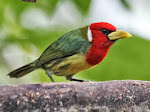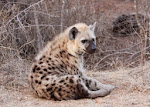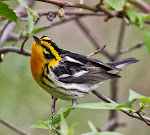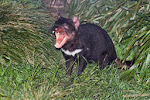
This is the story of one of the most strangest birds in all of Asia; the oddly-named Geomalia. The words "mysterious" and "enigmatic" have frequently been used in reference to this species; famed ornithologist, and frequent editor of all things bird-based, Guy Kirwan, once referred to this bird "...is generally considered to be one of the most enigmatic birds in Asia...". So a little background first, what is a Geomalia exactly? And herein lies the problem. The bird's very name is veiled in mystery, as it is said to be in reference to another bird that, like it, is confined to the highlands of the same Indonesian island of Sulawesi, the Malia Malia grata. However, if you look towards that species for any clues as to what exactly is a Geomalia, you may be left more confused. For Malia, is another Sulawesi species that has been confounding taxonomists since its discovery; some have listed it among the babbler family (Timalidae), while others have disagreed and grouped it instead with the very different bulbuls (Pycnonotidae).

The lonely Geomalia is known to inhabit the forest floor, where it is only ever seen on its own, and hops along with long, gangly legs, and a long, somewhat floppy tail. It is rarely seen off the ground, but In complete contrast, the mysterious Malia, is never seen on the ground at all, often seen in pairs creeping along large trunks and branches as they move within mixed feeding flocks. Which leaves those looking for clues from the Malia for getting to crux of the Geo-Malia, no less clear as to what it is at all! And there lies the background to what has made the Geomalia, which is not the brightest bird amongst a myriad bright species in Sulawesi, prominent in visiting birder's minds. On top of the fascinating fact that no one could quite agree what it was; it also seems to appear rare, and remains little known in other respects, with no recordings of its call ever made, and many experienced Sulawesi ornithologists claiming the call remains unknown even now, in the knowledge rich, Internet-driven age we live in, in 2015.

And then, to add to its outstanding allure, it occurs in mountain forests, which usually involve a hell of a hike to get into. With the call remaining curiously elusive to ornithologists; how then does one see a Geomalia? Well, in short you hike a steep, arduous track, and pray that the bird hops onto the track in front of you; which often feels a rather dim and distant hope. Many have gone in pursuit, and many have left wanting, with nether the merest glimpse of this avian wraith. Where to find one, is perhaps the least mysterious aspect in the story of a Geomalia; everyone knows the pace to find one is the infamous Anaso Track in Lore Lindu National Park, within Central Sulawesi. What makes this all the more troublesome is that this track for the much of the last decade has become impassable to all vehicles (due to a substantial landslide), save for madcap motorbike drivers, taking their lives in their hands as they bump their way up this jagged, steep, and rocky mountain track. So, a search for the Geomalia in this famed birding venue, means a hike, and a serious one at that; some 10 km+ round trip is needed in order to reach the remote parts of the track, where, just occasionally, this odd bird appears, and emerges out into the open from the dense cover of the surrounding forest. The mystery that has surrounded its position taxonomically have led many to assume that it may represent that most hallowed of birds; a monotypic (or single species) bird family. Birders feed off this kind of thing; birds like Kagu, Sapayoa, Shoebill and Przevalski's Rosefinch have ridden the wave of interest in such unique bird families, and have lured many birdwatchers to their haunts in pursuit of them. Unlike all other examples of bewitching monotypic bird families (and species), the Geomalia is most often missed when searched for; all the others from this elite group are usually readily found in the right place. This, of course, only adds to its allure, knowing that in all probability any short search for it is likely to be an empty one. For this reason some hardy birders took no chances; while most tour groups and birders head up the Anaso Track for a day or two from their relatively comfortable guesthouse in nearby Wuasa, some distance away, others decided to spend days, or even weeks, searching right where the bird occurs, by camping on site. In spite of such Herculean efforts, some unfortunate birding souls, still left without it, despite long days and nights spent under canvas, in the very heart of the bird's range. Such tales have found their place in birding folk lore, and in their infamy have haunted later birders who headed there in pursuit of this strangest of Oriental birds. For many years all that was around to guide birders to it, were only blurry photos, and odd pictures in field guides that seemed to little resemble the few poor photos that existed. In recent years, with the advent and rampant advance of digital photography, further photos have appeared, revealing it in more detail, only making it appear within reach, only for people to continue to go after the Geomalia, and to continue to leave without the Geomalia, with those hallowed images forever imprinted in their memories. It is fair to say that such pictures of the species have genuinely troubled some people, and haunted them in their own avian nightmares! Thus, any search for the mysterious Geomalia will definitely involve some sweat, maybe some blood, and perhaps some tears too.

In 2013 I finally made the journey to Sulawesi, an island I had admired from afar for some time, and an island's birdlife that I had long admired too. Top on my target list sat, of course, the fabled Geomalia. On my two trips to Sulawesi in that year, I spent many hours walking that blasted Anaso Track; and, I too, chose to take a shortcut to seeing it, by camping in the forests right where it hops. I tried every possible technique; we laid out rice along the trail, in the hope that the bird would quickly adopt to a new food; we tried standing quietly and watching the track from various directions; and we tried walking up and down relentlessly, and exhaustingly, all morning and afternoon long. Days passed, but the track remained entirely empty of birds, save for a solitary, and brief, Great Shortwing, which sent pulses racing when it first appeared, only for disappointment to set in once we realised it's obvious small size was a bad fit for Geomalia!

I should mention too that just before my 2013 tours it was revealed, through genetic work carried out by highly respected Swedish ornithologists Olssen and Alstrom that the mysterious Geomalia was not quite as mysterious as expected, and actually was a type of zoothera thrush after all! Many rued this loss, and feared its enigmatic status was lost forever. Indeed, the two family listers I was with on one tour in 2013 were happy to head down the Anaso Track without this bird, once this research had come to light. I knew well that had its mysterious status still been firmly in tact, we'd have spent a lot longer roaming the Anaso Track. However, in spite of this respected research published in 2013, in 2015 HBW Alive's website still holds two curious and enticing statements about the Geomalia: 1) "Current placement extremely tentative", and 2) "perhaps better treated as monotypic". For me anyway, the Geomalia remained mysterious, enigmatic, and my most wanted bird in Asia.

In 2015 I finally returned to Sulawesi, and, once again, Geomalia was right at the forefront of my thoughts. We were to be visiting the infamous Anaso Track for at least one day, and it was to be right near the start of the trip. Thus I thought, I could get the near inevitable dip (or miss) of Geomalia, out of the way early on, and then I could simply move on with the tour, and the rest of my "Geomalia-less" birding life. And so the day came when we were to climb the track. The group had been forewarned of the rigors involved, but in spite of the dire picture I painted, only one of eight people dropped out; the rest of us starting our walk up at 4:30am, well before the first rays of sunshine and the first birds of dawn, began to call. The hike was strenuous, and it was not long before we were well strung out along the track. After our first Satanic Nightjars (see earlier post), a few further people dropped out, and the group dwindled to just five. Knowing the alleged best time for the "bird on the track" was between 9am and 11am, I pushed on up, hoping beyond hope that we would make it to the unremarkable (but hallowed) stretch of trail in time for the bird still to be active. As I walked up I mused that the long period of dry weather (nearing a drought situation) in Sulawesi at the time of this visit surely could not be favourable for our quarry; typically ground feeding birds prefer feeding along damp tracks and trails, (I thought of Everett's Thrush in Borneo for example, and zoothera thrushes in general, now apparent relatives of the Geomalia following that unpopular 2013 research). Our local guide, Idris, however, seemed surprisingly upbeat about our chances and was firmly focused on the forest track. He led the group, being fit as a fiddle compared with the rest of us, who do not spend their lives walking this arduous mountain track. He walked slowly, and deliberately, with eyes fixed on the narrow, winding track ahead of us. He announced to all when we had reached the lowest point where it was known to occur, and revealed to us, that at any point above there we would be walking within the habitat of this revered species. Our attentions were heightened, and everyone was visibly tense, Idris included. Not long after we begun our "Geomalia walk", now with all present in a nervy single line, Idris looked particularly focused and quickly went shooting after something he had glimpsed by the side of the trail; I stood back to give him space, in fear of scaring whatever captivated his stare. The words "Geomalia!" were whispered, but in spite of me being just feet away from Idris, neither I, nor anyone else, saw a single feather of it, which scarpered into the forest before its name had even been completely uttered. A further scouring of the area saw us glimpse something racing across the trail at high speed, which was surely our bird, but no one was showing any kind of satisfaction at the sighting; if anything it was more frustrating than having not seen it at all. Many people had come and failed to see one Geomalia, but few (and perhaps none) had come and seen more than one in a single day. Thus, our single fleeting sighting of the day, a view that was nothing short of painful, was most likely to be all we were going to get. In my downtrodden mood, I revealed such thoughts to the group, who thankfully, like me, were not throwing in the towel just yet. Furthermore, Idris, the man with the most experience with Geomalias on the planet, seemed unperturbed too. This gave me hope, though I daren't voice this for superstitious fear that it may jinx us all! We continued on, under the advice of Idris who intriguingly revealed we were yet to reach the best area of the Anaso Track for the species. We ploughed on; with sweat pouring over us as we ascended further; but as yet no blood nor tears were in evidence. Some kilometre or more higher up, (and several Satanic Nightjars later), Idris froze once more, and incredibly mouthed the word "Geomalia!" again. I was mere paces away, and caught up with him in seconds, only to see an empty track in front of us. There was a corner though just ahead and so we moved very carefully forward, when, there, suddenly, on the track stood a thrush-like bird! I raised my binoculars in full expectation that I would be eyeballing the mysterious Geomalia with my optics for the very first time, only to realise the bird within my Swarovskis was not mysterious at all, but was indeed a certain thrush, a Sulawesi Thrush! On any other day, I would have been only to happy to look at a Sulawesi Thrush, but it's timing, and the situation, led me, and others in the group to view this particular individual rather unfavourably. I announced to the group that it was "only" a Sulawesi Thrush (a sin that I am ashamed of), but this left Idris exasperated, and he quickly insisted that he had not seen a Sulawesi Thrush, but a Geomalia. Confusion settled over the group, and we slowly walked forward, peeking around the next bend just ahead of us, when Idris stated for the third time that morning, (and more forcefully than ever) "G-E-O-M-A-L-I-A!". This time when I, and others, raised our binoculars, we were all ecstatic, as a bold leggy bird with a long, droopy tail stood conspicuously on the side of the trail. For once, the two bird theory was not a mere excuse for indiscretions, but an unquestionable reality. We revelled in this most mysterious of birds for a maximum of five minutes, before it disappeared to its most frequent haunt, the dark impenetrable depths of the mountain forest from whence it came.

A joyful group headed up the track, with little other avian distractions, save for a few White-eared Myzas (a highland honeyeater species); but no one caring for it was abundantly clear nothing, but nothing was going to stand in the way of our Geomalia for highlight of the day, or indeed the entire trip (and it was only day three, of twenty-one!) However, no one had banked on, another Geomalia, to show up. As we were reunited with Idris later that morning he informed us that one of the locals who had generously carried our lunch up the track, had walked right into a very tame Geomalia, but intriguingly from the description, it sounded much further up the track than both of the ones we had already seen. Intriguing indeed. As we needed to descend some to reach our lunch, we headed down anyway, and likewise walked into a very tame Geomalia, one that simply did not want to leave the track at all. By this time it was near noon; (and yes, well after the advertised best time for the bird). Photographers and birders alike lapped up the exceptional, long views of this bird, as it foraged in the open among darker stretches of the track, and even emerged out into the sunlight on brief occasions too. After every possible photo was taken, and it was seen from every possible angle, we were ready for lunch; trouble was the bird was barring our way to lunch. Eventually, after about an hour of walking behind it, and the bird hopping happily along ahead of us, we needed to make some progress, and had to shoo it off the track as we made our way to a pot of steaming rice and "ayam", or chicken. As it turned out, by the time we reached our lunch, having steadily walked behind the bird as it hopped ever lower down the track, we realised our food was not far from where the bird had last been seen hopping into the darkness. So, after taking some sustenance, a few of us went back up to investigate and see whether at 2PM in the afternoon, of all times, the bird had reappeared. Remarkably, it was back and happily feeding just a stone's throw from our lunch spot, where, after a time, we had to force ourselves to leave and head back down for home! A ridiculous experience with one of the most wanted of all Asian birds. I felt truly privileged. After this amazing viewing, one who had been unable to come with us on this day, returned with me and another person the following day, in the hope of a repeat performance. Our hope, what with this appearing to be a young bird, and oh so tame, and so willing to feed on the track, it was likely to be there again the next day. However, after a 10km round trip we encountered not a sniff of a Geomalia, which returned to being a mystery all over again! A footnote to all of this should be made that on examination of the photos, the distinctive worn tail of the last bird seen was noted to be different from photos of our second encounter, confirming to us that, incredibly, we had actually seen three different Geomalias in one barely believable morning!

More to come from the Indonesian island of Sulawesi soon...








































-Streamertail-Silver-Gap-Chalet-Blue-Mountains-Jamaica-22-March-2015_S9A5146.jpg)












